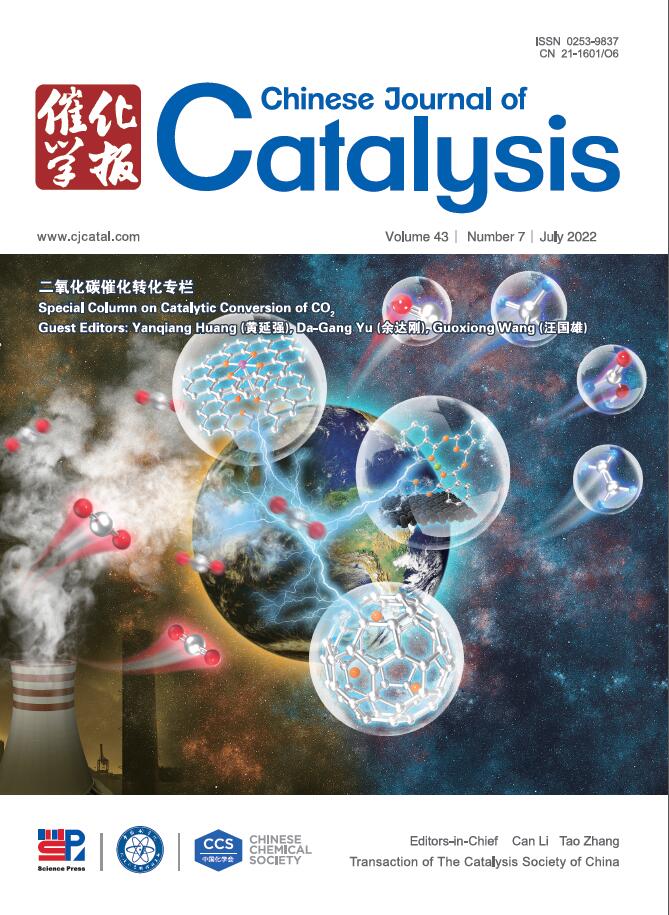硫锚定促进亚3nm In2S3纳米颗粒的稳定性,促进CO2电还原生成甲酸
IF 15.7
1区 化学
Q1 CHEMISTRY, APPLIED
引用次数: 0
摘要
p嵌段金属(In, Sn, Bi等)基电催化剂在电催化CO2还原(ECR)生成甲酸中表现出优异的活性。然而,在ECR条件下,催化剂重构和团聚导致的催化活性迅速下降,极大地限制了其实际应用。在此,我们开发了一种硫锚定策略,以稳定高密度的亚3nm In2S3纳米颗粒在硫掺杂多孔碳衬底(i-In2S3/S-C)上,用于甲酸盐的生产。系统表征表明,所制备的催化剂表现出强烈的金属硫化物-载体相互作用(MSSI),有效地调节了In2S3的电子态,在−0.95 V时,与RHE相比,甲酸法拉第效率高达91%。更重要的是,硫锚定有效地固定了亚3nm的In2S3纳米颗粒,防止了它们的团聚。与无硫锚定的In2S3样品相比,该催化剂具有更高的耐久性,说明催化界面上的强MSSI和快速电荷转移可以显著提高In2S3催化剂的结构稳定性。这些结果为开发高效、稳定的CO2还原电催化剂提供了可行的途径。本文章由计算机程序翻译,如有差异,请以英文原文为准。
Promoting stability of sub-3 nm In2S3 nanoparticles via sulfur anchoring for CO2 electroreduction to formate
The p-block metal (In, Sn, Bi, etc.)-based electrocatalysts have exhibited excellent activity in the electrocatalytic CO2 reduction (ECR) to formate. However, the rapid decrease in catalytic activity caused by catalyst reconstruction and agglomeration under ECR conditions significantly restricts their practical applications. Herein, we developed a sulfur anchoring strategy to stabilize the high-density sub-3 nm In2S3 nanoparticles on sulfur-doped porous carbon substrates (i-In2S3/S-C) for formate production. Systematic characterizations evidenced that the as-prepared catalyst exhibited a strong metal sulfide-support interaction (MSSI), which effectively regulated the electronic states of In2S3, achieving a high formate Faradaic efficiency of 91% at −0.95 V vs. RHE. More importantly, the sulfur anchoring effectively immobilized the sub-3 nm In2S3 nanoparticles to prevent them from agglomeration. It enabled the catalysts to exhibit much higher durability than the In2S3 samples without sulfur anchoring, demonstrating that the strong MSSI and fast charge transfer on the catalytic interface could significantly promote the structural stability of In2S3 catalysts. These results provide a viable approach for developing efficient and stable electrocatalysts for CO2 reduction.
求助全文
通过发布文献求助,成功后即可免费获取论文全文。
去求助
来源期刊

Chinese Journal of Catalysis
工程技术-工程:化工
CiteScore
25.80
自引率
10.30%
发文量
235
审稿时长
1.2 months
期刊介绍:
The journal covers a broad scope, encompassing new trends in catalysis for applications in energy production, environmental protection, and the preparation of materials, petroleum chemicals, and fine chemicals. It explores the scientific foundation for preparing and activating catalysts of commercial interest, emphasizing representative models.The focus includes spectroscopic methods for structural characterization, especially in situ techniques, as well as new theoretical methods with practical impact in catalysis and catalytic reactions.The journal delves into the relationship between homogeneous and heterogeneous catalysis and includes theoretical studies on the structure and reactivity of catalysts.Additionally, contributions on photocatalysis, biocatalysis, surface science, and catalysis-related chemical kinetics are welcomed.
 求助内容:
求助内容: 应助结果提醒方式:
应助结果提醒方式:


